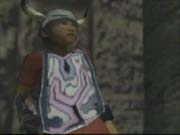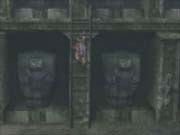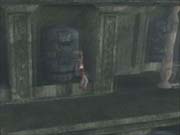ICO Preview
Read about Sony's hidden first-party gem.
ICO is the first-party Sony title that has gotten the least amount of attention from the North American media. Ironically, it is perhaps the console giant's most interesting game. Much of this is definitely Sony's own fault. The clever adventure has enjoyed nary a push from the company's advertising department, and members of the press have only recently (about a month before the game is due to ship) gained access to full playable copies.
And it's a shame. This is precisely the type of game that gets heralded as a sleeper hit, and, years after its initial, unappreciated release, a classic. The game is subtle, seamless, and engrossing, and it is, in many ways, the most visually interesting PlayStation 2 game yet to emerge. ICO stars a young boy (named Ico) with an odd mutation--growing from his head is a set of bull-like horns, and this has caused him all manner of trouble. See, every generation, a child is born in Ico's village with the aforementioned deformity. The people of the village maintain the brutal practice of banishing, and subsequently sacrificing, those very children. They're taken to a remote castle, in which they are locked and left to die.

The game begins with Ico being carted off to the castle by a gang of horsemen. Everything is depicted by means of a relatively nonintrusive in-game cinema, which serves as an exposition of the game's action and as an introduction to its inspired visual style. Sound is used subtly throughout the intro sequence, and the action spans many natural scenes. Halfway through, you're given a shot of the imposing structure in which the game is set: the frighteningly huge castle that Ico finds himself trapped in. After a series of shots depicting various details of the compound, the scene shifts to a body of water beneath and around the castle. Ico and the men who're transporting him are on skiffs, and they're languidly rowing. Ico himself sits dejectedly in the middle of one of the skiffs as the group approaches the landing. What follows is a series of scenes illustrating Ico's imprisonment in the castle's central chamber. The vault of the chamber in question is extremely high, and placed all around its walls are man-sized egg-shaped pods. The men--who used an enchanted sword to unlock a magically locked door--lead Ico into the chamber and lock him into one of the many pods, bidding him to not "think badly of them," as their actions are performed for the "good of the village." With his hands shackled to a block, Ico seems resolved to his fate, resolute as a man on the gallows. But then the ground begins to shake. The camera presents a view of the chamber outside of Ico's pod, which seems to be going through an odd metamorphosis--the ground beneath is actually rising, coming closer to Ico's isolated pod. All this crazy activity causes the foundation beneath the pod to buckle a bit, eventually tipping over. Ico manages to slip out before getting smashed by the heavy stone pod, though, very convincingly taking a spill on the stone floor, headfirst. He lies unconscious on the ground for a second, rocking his sacrificial wrap, before coming to. Once he's up, you're allowed a look at the game's focus: an enchanting, almost spectral young girl, whose interactions with Ico will set the tone for the game's pacing and define much of the action you'll engage in. Held in a giant birdcage-like cell way up above, the girl's form seemingly materializes out of shadows. Then, however, a very similar set of shadows animate on the wall behind Ico and cart him off. But not before allowing him a glimpse of the girl that he will invariably rescue.
Aesthetics
ICO's unique visual approach is the first thing you'll likely notice about it. Neither exuberantly realistic (Gran Turismo 3) nor indulgingly stylized (Jet Set Radio), the path that ICO walks is altogether subtler than either extreme. "Hazy" and "dreamlike" are two descriptors that would fit the game's mood well, though they don't really encapsulate the vast amount of imagery you'll encounter very accurately. Photo-realistic and multilayered textures are wrapped around the game's geometry, lending an air of believability to the game's environments. The environments themselves are rendered on an enormous scale; chambers vaster than the one Ico found himself in at the game's outset are pretty commonplace, and you'll come across structures within the environments--such as mechanical cranes, mine-cart systems, and windmills--that are large enough to constitute levels in themselves, had they been placed in any other game. The general feel you get as you traverse this daunting world is one of an ant among parked cars in a mall lot--you'll frequently get lost in wide camera views, focusing on the intricacies of the world's architecture, often with the ability to track past routes and plot possible future ones. Many of the game's camera positions are purposefully placed very far out so as to allow the scale of the affair to really set in. The adjustable camera, also, helps in accentuating the effect of scale--you can sweep it in any direction, and, although the path it follows is preset, the distance it allows you to travel is fairly vast.

In truth, few of the game's environments resemble what you'd find in most other 3D games. Rather than designing a level around obstacles (pits, traps, switch-activated elements, and such), ICO's environments seem to have been organically grown, so to speak, and made to resemble real-life spaces as closely as possible. This doesn't mean that the gameplay can't go down in a satisfying matter, however. Quite the contrary--through clever camera work, the game's designers have managed to tame the expansive environments, always providing you with a view that allows for 3D adventure gameplay, in the traditional sense.
But as inspiring as it is to watch Ico's interaction with the level architecture, it's the way the way he relates to the mysterious girl who quickly becomes his companion that will perhaps elicit the strongest reactions. Basically, the game's first sequence entails Ico rescuing the caged girl. From that point on, the gameplay is defined by Ico's interactions with her. He defends her from assaulting demons, catches her when she leaps across chasms, and the like. The subtle animation routines that permeate these interactions are quite charged, displaying a fluid, emotive quality seldom found in 3D design, much less most games. When Ico and the girl run hand in hand, for instance, you'll notice him periodically tug her when she lags behind, to which she responds with a slight start. Likewise when either one aids the other after a leap; when they reach for each other, every movement is lovingly accented, from the moment the hands make contact till they're both standing safe and sound, hand in hand. When this sort of subtle detail is worked into a game's most mundane systems, it really makes every moment spent with it more meaningful, and thus, enjoyable.

ICO's graphical style seems genuinely inspired. Technically, the characters are somewhat cartoonish, though their proportions and movements are grounded in reality. And when it comes down the amount of polys they're built of, they're probably very simple. Their no-frills designs, though, do much to help them mesh into the game's powerful, prominent environments--which, as it were, seem to be the game's true visual focus anyway. The general haze that's ever-present in the environments seems to help this feeling of continuity quite a bit. While there's little fogging in the bad sense, everything in the game seems possessed by a blurry quality, as if it's being viewed through a clouded, noisy lens. Far from detracting from the visual package as a whole, however, the haze wraps the game's many elements into a cohesive package, making each character, object, and effect weave seamlessly into the other.
Mechanics
The game systems that drive ICO are very, very simple. However, the richness of the environments provides you with much occasion to ply your abilities to very deep ends. Much like the classic side-scroller Prince of Persia, the character you control in ICO has a comparatively simple move set: he can jump, attack, and manipulate context-specific objects. He can also climb ladders, hang off of and shimmy across edges, and swing while on ropes or chains. You'll never need to do anything else, though--just like with any other well designed game, the tools with which you fulfill your objective are immediately available. Figuring out in what sequence to use them, though, is the trick.

Driving all this is a smooth control scheme. The left stick, as you'd imagine, controls Ico, while the right stick allows you to move the camera. The camera will automatically drift back to Ico, though, when released, so the views provided by it are relatively fixed. To the face buttons are mapped commands for jumping and attacking, as well as a context-sensitive action button. Finally, the R1 and R2 buttons control your interactions with the girl and zap the camera back in to place, respectively. You'll be far from the girl, a good deal of the time, so you'll make much use of the R1 command throughout the course of the game. Typically, Ico will cry for her loudly, but, depending on how close she is, he might motion for her to come closer, or, if there's a barrier between them, he'll goad her into jumping. Regardless of her distance, though, the camera will quite functionally drift over to her when you call, and it'll follow her path to you.
As you'd imagine, ICO's gameplay is primarily designed around complex sequences of simple tasks. The designers seem to employ a particular type of scenario to much effect: creating paths for your companion to safely traverse. As her sets of movements aren't as robust as Ico's, you'll constantly have to manipulate the game's environments in order to safely get her where she has to go. One sequence, for instance, involved the use of a mechanical crane to create a platform that she could use to safely cross a large chasm. To do this, you first have to get across a series of platforms in order to access the controls for the crane, which are located inside behind the battlements of one of the castle's many towers. Accessing them involves climbing a number of rungs on a sheer surface and covering some precarious ground up thousands of feet, before finally dropping into the nook where they lie. After activating the crane, of course, you have to go back all the way up and work your way down the chain that's connected to its arm. Only once you're on the crate that the crane is holding can you goad the girl into jumping onto it. These sorts of scenarios, at any rate, define the game's experience. Of course, they get much more complex and involved as the game progresses. You'll find yourself running through sewers, activating pressure plates, bombing foundations of bridges with makeshift explosives, and even leaping onto moving sails of windmills.

Combat's role in the game, refreshingly enough, is rather understated. The weapons Ico can use are always found within the game's environment--no interface breaks the pace at any point--and picking one up means dropping the other. Likewise, there is no life bar; Ico simply cannot die in combat. If you fail to defend your companion, however, the game will be over. And this will be a constant threat, as enemies--shadowy demons that materialize from thin air--will periodically appear throughout the game's environments and attempt to whisk the young girl away. The three-hit combo you can perform is usually more than enough to break them, however, so long as you don't drift too far from her. This sort of nonstandard pacing is quite refreshing in a 3D adventure, to say the least. Where combat in many 3D games seems like a means of fluffing otherwise staid sequences, all of ICO's battles--like its other elements--seem relevant, and their insertions are naturally paced.
In truth, there is a great deal to appreciate about this warm little game. Sadly, with so many games clamoring for the public's attention, it will be very easy for it to be overlooked--more so given Sony's apparent disinterest in promoting it to any significant degree. The game is set to ship in September, in any event, so remain in the vicinity for a full review come then.
Got a news tip or want to contact us directly? Email news@gamespot.com
Join the conversation